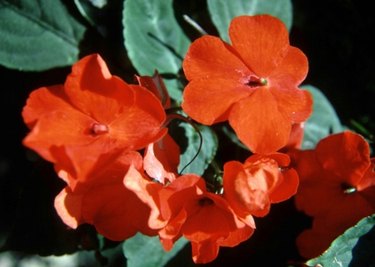
Impatiens (Impatiens walleriana) is an annual flowering plant that is easy to grow and provides abundant flowers from late spring to fall. They have glossy, medium-sized leaves and bear 1 to 2 inch red, white, pink, violet or orange flowers in single or double varieties. Impatiens grow to 12 to 18 inches tall. Although generally disease and pest resistant, impatiens problems can develop, some of which often cause white spots on these lovely plants.
Growing Impatiens Is Easy
Video of the Day
Grow impatiens from seed or seedlings purchased from your local garden center. Start seeds indoors eight to 10 weeks before the anticipated transplant date when all frost danger has passed. Outdoors, impatiens prefers partial shade with moist, well-draining soil. Two to four hours of direct sunlight is all that impatiens need. Plants grown in heavy shade bloom less but grow taller.
Video of the Day
Apply a slow-release fertilizer at planting. Water your impatiens at least once each week during dry weather. Because they enjoy a moist, well-drained environment, group impatiens with other plants with similar watering and cultural requirements.
Monitoring Impatiens Problems
Impatiens are generally known as hardy plants with few pest and disease problems. However, temperature and irrigation variations may weaken the plant, allowing insects and pathogens to take hold. Monitor the impatiens closely for infestation signs on stems and the leaves' undersides. Remove discolored, wilted or stunted leaves and blossoms, as these are the signs of plant problems. Treating impatiens problems early helps protect the plant's health and blooming ability.
Powdery Mildew Fungus
Powdery mildew is a white, mealy fungus growing on the tops of leaves. A number of different plant pathogens cause it. Powdery mildew develops when there is a fluctuation of warm and cool temperatures with a relative humidity of 85 percent. The mildew appears as white spots, which is very distinct on red flowers. When the fungus grows heavily, it manifests as a grayish growth on leaves and may give the appearance of white spots on impatiens. Triflumizole fungicide helps protect plants from this disease, according to Penn State University. Chlorthalonil is recommended if the plants are not flowering.
For gardeners preferring a more organic approach, spray infected plants with a solution of 1 teaspoon of baking soda added to 1 quart of water. Treat the plants once weekly during the growing season until all signs of powdery mildew are eliminated. For added punch, alternate weekly sprayings between the baking soda solution and neem oil spray. Oils are safe to use on impatiens as long as temperatures don't exceed 80 degrees F.
Eliminate Impatiens Thrips Quickly
Western flower thrips are small insects about 1/16 inch long that collect on the leaves' undersides. They are slender with wings and may be yellow-brown to dark-brown in color. These insects suck juices from the leaves, causing discolored, pale spots on flowers. Thrips in small numbers do not harm the plant's health, but large numbers can cause severe distortion.
Possibly the most insidious of all impatiens problems, thrips are often the carriers of more sinister diseases which they spread from plant to plant. Monitor thrips activity with sticky traps and treat with spinosad until the population is eradicated.
Impatiens Necrotic Leaf Spot
Impatiens necrotic leaf spot, formerly called tomato virus leaf spot, is a disease caused by impatiens necrotic spot virus (INSV), a member of the tospovirus virus family. Necrotic leaf spot commonly afflicts impatiens and other garden flower plants. Thrips transmit this viral disease, which spreads rapidly throughout the garden bed. Symptoms include darkened, concentric spots on impatiens, browning leaf edges and general decline of the plant.
Because these viral infestations are incurable, infected plants must be removed from the collection. Destroy all infected plant material – do not add it to composting. Be aggressive about your weed control because weeds are known to harbor tospovirus.